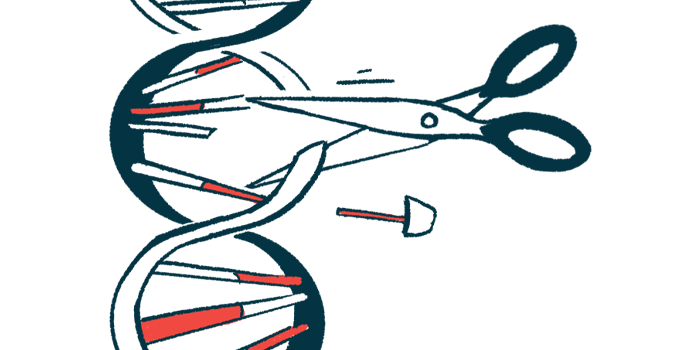CRISPR/Cas9 Gene Editing Used to ‘Cut Out’ ALS Mutation: Early Study
System shows proof-of-concept effects in reducing production of toxic molecules

A CRISPR/Cas9 gene editing system can be used to remove the repeat expansion in the C9ORF72 gene, the most common genetic cause of amyotrophic lateral sclerosis (ALS), a new study reports.
The system showed positive proof-of-concept effects in mouse models and in human cells, reducing the amount of faulty RNA molecules and small proteins that contribute to nerve cell death in ALS. RNA is the intermediate molecule produced from a DNA sequence that serves as a template for protein production.
The study, “CRISPR/Cas9-mediated excision of ALS/FTD-causing hexanucleotide repeat expansion in C9ORF72 rescues major disease mechanisms in vivo and in vitro,” was published in Nature Communications.
ALS-causing C9ORF72 mutations involve abnormal repeats of DNA sequence
The causes of ALS are not completely understood, but some cases are associated with genetic mutations. Mutations in a gene called C9ORF72 are the most common genetic cause of ALS, found in about 40% of familial cases and 5% of sporadic cases.
ALS-causing mutations in C9ORF72 mainly involve an abnormal repeat of a certain sequence of DNA, called an hexanucleotide repeat expansion (HRE). In the gene, there is a region where six nucleotides (the “letter” of the genetic code), namely GGGGCC, are repeated multiple times. In healthy versions of the C9ORF72 gene, there are about two dozen repeats, but in ALS-causing mutations, there can be hundreds or even thousands of these repeats.
The HRE interferes with production of the C9ORF72 protein and leads to the formation of toxic RNA intermediate molecules and small proteins, all of which is thought to contribute to the progression of ALS.
CRISPR/Cas9 was developed by manipulating a similar system that bacteria use to defend themselves against viral infection. Very simplistically, CRISPR/Cas9 gene editing can be used to “cut out” a specific region of DNA.
These proof-of-concept findings support the view that CRISPR methodologies should be explored as a strategy to halt or slow disease progression in [ALS] patients, and potentially other disorders caused by expanded domains of repeated DNA
In the study, researchers developed a CRISPR/Cas9 system to “cut out” the HRE in an ALS-mutant version of the C9ORF72 gene, without affecting the parts of the gene that provide instructions for making the C9ORF72 protein.
To deliver the system to cells, it was packaged in adeno-associated virus (AAV) vectors. AAV is commonly used in gene therapy applications because it can effectively deliver genetic cargo to human cells and is easy to manipulate in a laboratory, but it doesn’t cause notable illness in people.
“AAV has many advantages and is presently regarded as the safest and most effective gene therapy vector for the [brain and spinal cord], with potentially a long-lived therapeutic effect following a single treatment,” the researchers wrote. However, they stressed that the viral vector they used was “merely a delivery tool for a proof-of-mechanism,” noting that other delivery tools will likely be better suited for clinical applications.
After designing the system and conducting initial proof-of-concept and refinement tests in cell lines, the researchers tested the system in several models of ALS.
First, in a battery of experiments done in mouse cell models, the researchers demonstrated that the system could efficiently remove the HRE from nerve cells harboring the ALS-causing mutation in C9ORF72. As designed, the CRISPR/Cas9 system did not interfere with production of the C9ORF72 protein, but it markedly reduced the production of toxic intermediate molecules made from the HRE.
CRISPR/Cas9 was able to reduce production of toxic molecules
Additional experiments done in three mouse models of ALS yielded generally consistent results, with the system effectively removing the HRE and decreasing toxic intermediate production, without affecting C9ORF72 protein levels.
Of note, because the CRISPR/Cas9 system was relatively large, it needed to be delivered to the mice using two separate AAV vectors. Analyses showed that most of the mice’s cells were delivered genetic cargo from both vectors.
In a final set of experiments, the researchers tested the system in human nerve cells derived from people with ALS caused by C9ORF72 mutations. Consistent with the mouse experiments, results showed that the system could reduce the production of toxic molecules without interfering with C9ORF72 protein levels — in fact, data suggested the system may increase C9ORF72 protein expression in human cells.
“These proof-of-concept findings support the view that CRISPR methodologies should be explored as a strategy to halt or slow disease progression in [ALS] patients, and potentially other disorders caused by expanded domains of repeated DNA,” the researchers concluded.








